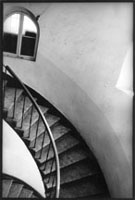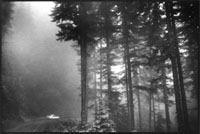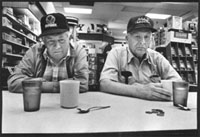No Limits
The Reality Of Black And White
Judah S. Harris tells this
story about one of his photos: "I had just bought a new Bogen
tripod, and I went out in the Olympic National Forest area in Washington
to photograph with it. I left my rented car down on the road. I wanted
to photograph nature, and I certainly didn't want the car in the
picture. But as I was heading away from the car, I turned around."
What he saw was a picture waiting only for the taking, and the resulting
dramatic black and white photograph was not only an artistic success
but also a commercial one. It's been used as a book cover (with
a little manipulation, Harris' rented car became a trooper's
cruiser) and in a gatefold magazine advertisement (where, with the application
of a bit of digital magic, the rental's place was taken by a BMW). |
|||||||
"In my own way"
is the key. If scope of subject matter isn't the first thing you
notice about Harris' photos, then vision is. As a photojournalist,
fine art and commercial photographer, Harris' curiosity and creativity
combine with opportunity to produce images that are perhaps as much about
him as they are about the subjects he chooses to photograph. |
|||||||
Another reason a person might
question Harris' statement that his work is about reality is the
fact that for much of his work, he chooses black and white film. Artistic,
yes, but real? After all, we see the real world in color. |
|||||||
Harris markets his photographs for editorial illustrations, book covers, advertisements, and stock; he also sells them as fine art. Commerce, however, was not the original intent. "Initially photography was a hobby, an avocation," he says. "Then, in 1990, I put together a portfolio and started knocking on doors. There was no thought that I need a profession, so I'll be a photographer. The goal was to be true to my photographic vision and then see if I could find an audience receptive to it. "I think it's good
to be attuned to what the commercial needs are. I keep in mind that this
or that might make a good photograph for the cover of a book, but what
I most want to do is to keep photographing things that are of interest
to me." |
|||||||
Harris' 35mm camera is
a Minolta X-700, which is likely to be fitted with his favorite lens--a
28mm--and loaded with either Tri-X 400 or T-Max 100. Computer manipulation
is not out of the question for the future. "I want to learn more
about Photoshop," he says. "As a realist I don't want
to go around changing a lot of things, but the other reality is that I
can take these tools and use them in my own philosophy. I can be a realist
and want to document real life and still go ahead and contrive something
with Photoshop that might still allow me to be true to my realism." |
|||||||
|
|
||||||








































